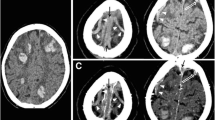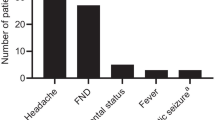Abstract
Internal jugular vein (IJV) stenosis and cerebral venous sinus (CVS) stenosis belong to cerebral venous outflow insufficiency. This study aimed to analyze the similarities and differences between IJV stenosis and CVS stenosis. Patients with either IJV stenosis or CVS stenosis confirmed by contrast-enhanced magnetic resonance venography between October 2017 and July 2018 were enrolled in this retrospective study. The similarities and differences between IJV stenosis and CVS stenosis on the aspects of clinical and imaging features were compared. A total of 82 eligible patients entered into the final analysis. The similarities of the two subsets of cerebral venous outflow insufficiency mainly included headache, head noises or tinnitus, visual disorders, and sleeping disorders, as well as cloud-like white matter hyperintensity in T2WI and FLAIR sequences of MRI. However, there were differences in between, the ratio of patients with higher intracranial pressure (ICP) was common in CVS stenosis (p < 0.001). Namely, higher ratios of papilledema (p = 0.001) and visual damage (p = 0.029), as well as poor Frisen papilledema grade scores were more commonly observed in CVS stenosis (p = 0.004), while abnormal collateral-vessels appeared more frequently in IJV stenosis (100.00%) than CVS stenosis (28.57%). Continuous head noises, tinnitus and cloud-like white matter hyperintensity in MRI are the features of both IJV stenosis and CVS stenosis. Whereas, severe headache, visual damage, papilledema, and intracranial hypertension (IH) were more common in CVS stenosis, and the appearance of collateral-vessels is a key feature of IJV stenosis.


Similar content being viewed by others
Abbreviations
- IJV:
-
Internal jugular vein
- CVS:
-
Cerebral venous sinus
- ICP:
-
Intracranial pressure
- IH:
-
Intracranial hypertension
References
Ridha MA, Saindane AM, Bruce BB et al (2013) MRI findings of elevated intracranial pressure in cerebral venous thrombosis versus idiopathic intracranial hypertension with transverse sinus stenosis. Neuro-Ophthalmology 37(1):1–6
Zhou D, Ding JY, Ya JY et al (2018) Understanding jugular venous outflow disturbance. CNS Neurosci Ther 24(6):473–482
Farb RI, Vanek I, Scott JN et al (2003) Idiopathic intracranial hypertension: the prevalence and morphology of sinovenous stenosis. Neurology 60(9):1418–1424
Shazly TA, Jadhav AP, Aghaebrahim A et al (2018) Venous sinus stenting shortens the duration of medical therapy for increased intracranial pressure secondary to venous sinus stenosis. J Neurointerv Surg 10(3):310–314
Fields JD, Javedani PP, Falardeau J et al (2013) Dural venous sinus angioplasty and stenting for the treatment of idiopathic intracranial hypertension. J Neurointerv Surg 5(1):62–68
Zhou D, Meng R, Zhang X et al (2018) Intracranial hypertension induced by internal jugular vein stenosis can be resolved by stenting. Eur J Neurol 25(2):365–e13
Donnet A, Metellus P, Levrier O et al (2008) Endovascular treatment of idiopathic intracranial hypertension: clinical and radiologic outcome of 10 consecutive patients. Neurology 70(8):641–647
Hjermstad MJ, Fayers PM, Haugen DF et al (2011) Studies comparing numerical rating scales, verbal rating scales, and visual analogue scales for assessment of pain intensity in adults: a systematic literature review. J Pain Symptom Manag 41(6):1073–1093
Kosinski M, Bayliss MS, Bjorner JB et al (2003) A six-item short-form survey for measuring headache impact: the HIT-6. Qual Life Res 12(8):963–974
Frisen L (1982) Swelling of the optic nerve head: a staging scheme. J Neurol Neurosurg Psychiatry 45(1):13–18
Peng KP, Fuh JL, Wang SJ (2012) High-pressure headaches: idiopathic intracranial hypertension and its mimics. Nat Rev Neurol 8(12):700–710
Leach JL, Jones BV, Tomsick TA et al (1996) Normal appearance of arachnoid granulations on contrast-enhanced CT and MR of the brain: differentiation from dural sinus disease. AJNR Am J Neuroradiol 17(8):1523–1532
Han Y, Yang Q, Yang Z et al (2017) Computational fluid dynamics simulation of hemodynamic alterations in sigmoid sinus diverticulum and ipsilateral upstream sinus stenosis after stent implantation in patients with pulsatile tinnitus. World Neurosurg 106:308–314
Eisenman DJ, Raghavan P, Hertzano R et al (2018) Evaluation and treatment of pulsatile tinnitus associated with sigmoid sinus wall anomalies. The Laryngoscope 128(Suppl 2):S1–S13
Li K, Ren M, Meng R et al. (2018) Efficacy of stenting in patients with cerebral venous sinus thrombosis-related cerebral venous sinus stenosis. J Neurointerv Surg. https://doi.org/10.1136/neurintsurg-2018-014328
Ding J, Zhou D, Geng T et al (2018) To predict visual deterioration according to the degree of intracranial hypertension in patients with cerebral venous sinus thrombosis. Eur Neurol 80(1–2):28–33
Xu X, Wang B, Ren C et al (2017) Age-related impairment of vascular structure and functions. Aging Dis 8(5):590–610
Chung WS, Lin CL, Kao CH (2015) Diabetes increases the risk of deep-vein thrombosis and pulmonary embolism. A population-based cohort study. Thromb Haemost 114(4):812–818
Radvany MG, Solomon D, Nijjar S et al (2013) Visual and neurological outcomes following endovascular stenting for pseudotumor cerebri associated with transverse sinus stenosis. J Neuro-ophthalmol 33(2):117–122
Ahmed RM, Wilkinson M, Parker GD et al (2011) Transverse sinus stenting for idiopathic intracranial hypertension: a review of 52 patients and of model predictions. AJNR Am J Neuroradiol 32(8):1408–1414
Ding J, Zhou D, Sui M et al (2018) The effect of normobaric oxygen in patients with acute stroke: a systematic review and meta-analysis. Neurol Res 40(6):433–444
Higgins JN, Garnett MR, Pickard JD et al (2017) An evaluation of styloidectomy as an adjunct or alternative to jugular stenting in idiopathic intracranial hypertension and disturbances of cranial venous outflow. J Neurol Surg Part B 78(2):158–163
Acknowledgements
We would like to thank all patients and doctors who participated in this study for their cooperation.
Funding
This study was sponsored by the National Key R&D Program of China (Grant No. 2017YFC1308400), the National Natural Science Foundation (81371289), the Project of Beijing Municipal Top Talent for Healthy Work of China (2014-2-015).
Author information
Authors and Affiliations
Corresponding author
Ethics declarations
Conflict of interest
The authors report no conflict of interest.
Rights and permissions
About this article
Cite this article
Bai, C., Xu, Y., Zhou, D. et al. The comparative analysis of non-thrombotic internal jugular vein stenosis and cerebral venous sinus stenosis. J Thromb Thrombolysis 48, 61–67 (2019). https://doi.org/10.1007/s11239-019-01820-1
Published:
Issue Date:
DOI: https://doi.org/10.1007/s11239-019-01820-1




